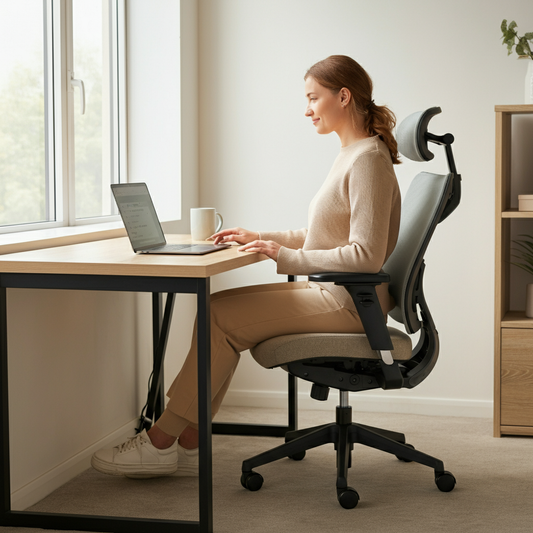Choosing the right ergonomic office chair is essential for your comfort, health, and productivity. However, finding the perfect fit isn’t just about picking a chair with adjustable features—it’s about knowing your own body measurements and matching them to the chair’s specifications. In this guide, we’ll walk you through the step-by-step process of measuring yourself for an ergonomic office chair, ensuring you achieve the ideal fit for your unique body type.
Why Proper Measurements Matter
An ergonomic office chair is designed to support your body in a neutral posture, reducing strain on your muscles and joints. However, even the best chair won’t provide the intended benefits if it doesn’t fit your body properly. Here’s why taking accurate measurements is crucial:
- Improved Posture: A well-fitted chair helps maintain the natural curves of your spine, reducing the risk of back pain.
- Enhanced Comfort: Proper measurements ensure that the chair supports your body without causing pressure points or discomfort.
- Increased Productivity: When you’re comfortable, you can focus better and work more efficiently.
Tools You’ll Need
Before you start measuring, gather the following tools:
- A tape measure for accurate measurements.
- A smartphone or camera to take photos or videos for reference.
- A helper (optional) to assist with measurements, especially for hard-to-reach areas.
Step-by-Step Guide to Measuring Yourself
Follow these steps to measure your body and match the results to ergonomic chair specifications:
1. Measure Your Height
- Stand upright against a wall with your feet flat on the floor.
- Use a tape measure to record your height from the floor to the top of your head.
- Why It’s Important: Your height determines the overall size and adjustability range of the chair you need.
2. Measure Your Leg Length
- Sit on a flat surface with your feet flat on the floor.
- Measure the distance from the floor to the back of your knee (popliteal height).
- Why It’s Important: This measurement helps you choose a chair with the right seat height, ensuring your feet rest flat on the floor.
3. Measure Your Thigh Length
- Sit on a flat surface with your back straight and your knees bent at a 90-degree angle.
- Measure the distance from the back of your knee to the base of your lower back.
- Why It’s Important: This determines the ideal seat depth, ensuring the chair supports your thighs without cutting off circulation.
4. Measure Your Torso Length
- Sit upright on a flat surface with your back straight.
- Measure the distance from the base of your spine (tailbone) to the top of your shoulders.
- Why It’s Important: This helps you choose a chair with a backrest that provides adequate support for your upper back and shoulders.
5. Measure Your Arm Reach
- Sit with your arms bent at a 90-degree angle.
- Measure the distance from your elbow to the tips of your fingers.
- Why It’s Important: This ensures the armrests are positioned correctly to support your arms without straining your shoulders.
6. Measure Your Shoulder Width
- Stand upright and measure the distance between the outer edges of your shoulders.
- Why It’s Important: This helps you choose a chair with armrests that can adjust to your shoulder width.
How to Match Measurements to Chair Specifications
Once you’ve taken your measurements, compare them to the specifications of the ergonomic chairs you’re considering. Here’s what to look for:
1. Seat Height
- The chair’s seat height should adjust low enough for your feet to rest flat on the floor, with your knees bent at a 90-degree angle.
2. Seat Depth
- The seat depth should allow 2-3 inches of space between the back of your knees and the seat edge.
3. Backrest Height
- The backrest should support your entire back, from your lower spine to your shoulders.
4. Armrest Adjustability
- The armrests should adjust to match your arm reach and shoulder width, providing support without causing strain.
Printable Measurement Checklist
To make the process easier, we’ve created a downloadable measurement checklist. Use this checklist to record your measurements and compare them to the specifications of the chairs you’re considering. Download the Measurement Checklist.
Recommended Ergonomic Chairs from Lundia
At Lundia, we offer a range of ergonomic office chairs with adjustable features to suit every body type. Here are some of our top recommendations:
1. Lundia FitPro™ Chair
- Features: Adjustable seat height, depth, and lumbar support.
- Why It’s Great: Perfect for users who want a fully customisable fit.
2. Lundia ErgoMeasure™ Chair
- Features: Built-in measurement guides and 4D armrests.
- Why It’s Great: Designed for users who prioritise precision and comfort.
3. Lundia CustomFit™ Chair
- Features: Wide range of adjustability and reinforced base.
- Why It’s Great: Ideal for users with unique body measurements.
Explore our full range of Ergonomic Office Chairs to find the perfect fit for your needs.
Why Proper Fit Matters
Investing in an ergonomic office chair that fits your body perfectly isn’t just about comfort—it’s about your health and productivity. A well-fitted chair can:
- Reduce the risk of back pain and other musculoskeletal issues.
- Improve your posture and circulation.
- Enhance your focus and efficiency at work.




